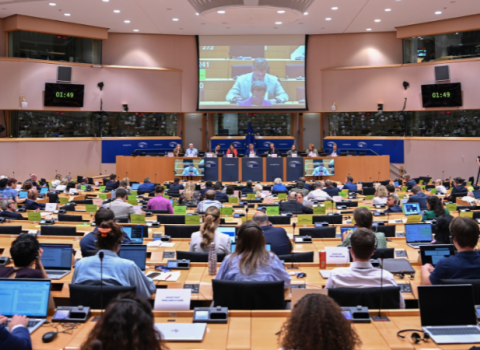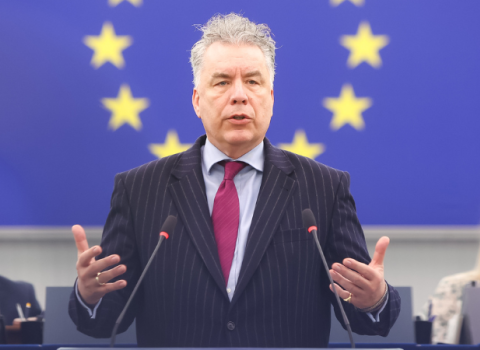The EU has acted on some research and innovation recommendations, but fallen short on others. Science|Business unpicks progress so far

Former Italian Prime Minister Mario Draghi. Photo credits: Alexis Haulot / European Union
It’s been nearly one year since former Italian Prime Minister Mario Draghi spelled out in excruciating detail the depth of the EU’s economic woes.
Few had denied the bloc was falling behind the US, especially in digital technologies. But Draghi’s blockbuster 401-page chronicle of decline ratcheted up the urgency considerably, and economic competitiveness has become the leading priority of the current European Commission, which took office last year.
One year on, the EU’s weakness in relation to Washington and Beijing, particularly due to technological and security dependence on the US, appears even more acute. Earlier this month, Brussels signed an unequal trade deal with US President Donald Trump, promising to buy hundreds of billions of euros of US fossil fuels, and $40 billion of AI chips.
The lessons in the report are “even more urgent” now than a year ago, Draghi said during a panel discussion on August 26.
There are grounds for hope, he added, but “no continent that wants to have geopolitical power and wants to preserve its existence from an economic and social viewpoint, can be excluded from disruptive technologies.”
Draghi did offer one crumb of comfort: that under Donald Trump, the US is now a less attractive destination for relocating European start-ups. “Maybe things change now,” he said.
One of the key messages of Draghi’s report was that Europe had so far missed the boom in digital technologies. Given the importance of tech in Draghi’s assessment, the report contained numerous prescriptions on how to improve European research and innovation, and crucially, how it can be parlayed into EU-based cutting-edge companies.
So, one year on, have Draghi’s recommendations been taken up? Science|Business weighs up progress so far.
The Framework Programmes
The Draghi report contained a number of overarching recommendations to reform the EU’s multi-billion euro research and innovation Framework Programmes. Plans for FP10, the programme due to start in 2028, were released in July by the Commission, and these proposals address some of Draghi’s ideas, but ignore others.
- “Design a simpler and more impactful tenth EU R&I Framework Programme.”
The Commission, as per usual, has pledged to cut back on bureaucracy for applicants, by expanding so-called lump sum funding, designed to reduce reporting requirements, and by making grant calls less proscriptive, offering applicants more freedom to tackle problems from different angles.
Grant winners currently twiddle their thumbs for an average of 240 days between a call closing and receiving money, a waiting time that is even longer than under the previous programme. On this lag, the Commission’s ambitions are modest: in FP10 it wants to reduce maximum waiting times from eight to seven months.
However, the Commission is already rolling out simplifications in the current programme, Horizon Europe. For example, it’s introduced some two-stage applications, to weed out more proposals during a quick first round, saving everyone time.
- “Refocus the next Framework Programme on selected priorities (new ‘EU Competitiveness Priorities’).”
Draghi was also keen to make sure the Framework Programmes, and particularly Pillar 2, which funds research and industrial consortia, are more tightly bound to overarching EU priorities.
This demand has indeed been taken up: most of Pillar 2 will be steered by a new European Competitiveness Fund, which consolidates a grab bag of existing instruments to try to make them easier to access and more coordinated under EU policies.
- “Increase the budget to €200 billion.”
On this recommendation, the Commission has fallen short. It recommends an FP10 budget of €175 billion. And if member states nibble away at this proposed budget during negotiations, as they did with Horizon Europe, FP10’s budget will be reduced to €139 billion when it starts in 2028, far below what Draghi thinks is needed.
- “Launch a highly competitive programme to foster the emergence of world-leading research institutions (an ‘ERC for institutions’ programme).”
Draghi worried that the EU doesn’t have enough universities at the very top of institutional rankings. While he admitted these rankings are flawed, this lack of concentration means the bloc doesn’t have hotspots of critical mass in talent and money seen in the UK, US or China.
“We struggle with having research or innovation [. . .] at the very frontier, but that's where the big productivity gains come from, ultimately,” he said earlier this week.
His recommendation is for the EU to start directly funding universities to propel a select few to the top of these rankings.
But so far, no such schemes have been proposed. Given that this would likely benefit already rich universities, in wealthier EU states, it’s bound to be controversial.
- “Introduce a favourable regime to attract top researchers (‘EU Chair’).”
This recommendation has been indirectly answered in the form of the EU’s €500 million Choose Europe scheme, implicitly aimed at disaffected US researchers fleeing a barrage of hostility and cuts from the Trump administration. However, it’s unclear if European universities will have the budgets to take advantage of Choose Europe funding, which only funds positions for 2-3 years, after which the university takes over.
- “Establish an EU R&I Action Plan; coordinate member states’ R&I plans, setting priorities, fostering collaboration and initiating joint projects.”
So far, there’s still little sign that EU member states are finally willing to coordinate their national research and innovation spending so as to avoid overlap. The idea that “you have to give a little bit [of research funding] to everybody” is “exactly what you should not do to get to disruptive technology, disruptive innovation,” said Draghi earlier this week. He wants the EU to coordinate “streams of research” into a few centres of excellence and focus funding there.
“While the Horizon Europe proposal seems to be rather bold, the proof will be in the concrete measures that will be taken to coordinate policies at the EU level, and also between EU and national level,” said Andrea Renda, director of research at the Centre for European Policy Studies, who has co-authored several reports on the future of the Framework Programmes.
- “The overall budget allocation should be re-thought and re-directed towards the financing of disruptive innovation which now absorbs only 5% of the budget.”
Draghi argued that the Framework Programmes are too focused on “addressing capital market imperfections,” that is, giving companies the money to scale up, and “benefiting mature companies,” which are typically the big winners of Pillar 2 consortia grants. Instead, he wants support for radical new inventions at early stages.
In response, the Commission has indeed shifted budgets. The European Innovation Council (EIC), whose Pathfinder grants fund what Draghi considers real, early-stage disruptive innovation, will see its share of FP10’s budget rise to 22.2%, up from 14.2% of Horizon Europe. The proportion going to Pillar 2 will fall, from 54% to 43.4%.
The European Innovation Council
The EIC, a relatively new body focused on financing start-ups and new technologies, is Draghi’s favoured tool for making the EU’s Framework Programmes more economically impactful. He wants the council to operate more along the lines of the US Defense Advanced Research Projects Agency (DARPA), which gives programme managers huge budgets and freedom to make risky bets on radically new technologies.
So far, there’s a top-line commitment to incorporate “more ARPA elements into its operations, where high risk projects are supported in stages, or discontinued,” according to the Commission’s FP10 plans, but not a great deal of detail.
“The EIC could become more DARPA like, but we haven't seen any specific plan in that respect,” said Renda.
- The EIC should make “greater use of innovation challenges, similar to those developed by the German Sprind agency, should be the preferred approach.”
Starting next year, the EIC will take up Draghi’s suggestion and launch Advanced Innovation Challenges. Modelled on Germany’s Sprind innovation agency, several teams will be given up to €300,000 to conduct a feasibility study of a new technology in response to a EIC-defined challenge. Then, the most successful get up to €2.5 million to develop a real-world prototype.
- “The existing EIC Pathfinder should be reformed to improve its governance and then endowed with substantially greater resources to become a genuinely new ‘ARPA-type agency’.”
Draghi wants the EIC to prioritise is Pathfinder grants, which offer up to €4.5 million to promising but very early-stage technology ideas. However, the EIC also offers other forms of support, including its Accelerator grants, which are designed to help start-ups with a close-to-market product scale up.
The DARPA model is “quite clearly only Pathfinder”, said Daniel Gros, director of the Institute for European Policymaking at Bocconi University, whose reports had a significant influence on Draghi’s report.
However, it’s unclear yet whether the EIC will shift its emphasis to Pathfinder grants, as Draghi recommends. It has increased the maximum Pathfinder budget, but it’s down to the Commission to set the balance between different types of grants. The Commission’s FP10 proposal acknowledges the EIC’s “dual role” in backing both early-stage tech and helping start-ups scale up, a spokesman for the council said.
- “The European Innovation Council currently lacks the scale and the diverse set of expertise necessary to make strategic decisions in highly specialised fields.”
As mentioned above, the EIC will be the big winner under FP10, with its budget set to increase by 139% to close to €40 billion over seven years. Yet currently, it only has 10 programme managers, which is arguably a thin spread of expertise across the fields it wants to cover.
- “It needs to have a high degree of independence in how it selects and manages the development of disruptive solutions and breakthrough projects.”
After 2028 under FP10, the Commission’s proposal suggests the EIC’s programme managers will have more autonomy, although there are very few details so far. EIC president Michiel Scheffer has said they might get a stronger say in which projects get selected, or the power to stop failing projects. “It’s a step in the right direction,” said Gros of the mooted changes.
What’s more, under FP10, the EIC president will no longer be an employee of the Commission, which “points to greater independence,” said an EIC spokesperson.
Related articles
- How FP10’s budget compares to Horizon Europe
- Has the European Commission listened to its advisors on FP10?
- Horizon Europe budget to double, but €68B will remain in Competitiveness Fund
However, the EIC president will have their term of office reduced from four years to two, renewable once. Gros worries this is an attempt to limit the president’s autonomy by making their position less secure. “It just doesn’t make sense,” he said of the changes. “There’s no reason at all.”
On the other hand Scheffer, the current president, has said he isn’t perturbed by the proposed term reduction.
The European Research Council
- “Double the support to ground-breaking fundamental research through the European Research Council.”
Draghi is a fan of the ERC, and sees its bottom-support of top-notch scientific projects as an important part of the EU’s ecosystem.
In budget terms, the Commission has listened, and will increase funding for “excellent science,” which includes the ERC and Marie Skłodowska-Curie Actions, which train doctoral students and postdocs, from €22.6 billion under Horizon Europe to €41.5 billion in FP10. If inflation is taken into account, though, this will be more like a 50% uplift, rather than a real-terms doubling of support.
- “The design of the ERC should remain untouched, preserving its independence and focusing on the financing of truly innovative research projects by top scholars over a five-year period.”
Rather than leaving the ERC’s governance untouched, as Draghi recommends, the Commission has proposed cutting the ERC president’s term from four years to two, just as it suggests for the EIC.
This proposed change has outraged even the Commission’s own advisors, who see it as an attempt to kneecap the ERC president’s independence in Brussels.
The question now is whether EU governments will accept the Commission’s recommendations for FP10, or add changes of their own, before it starts in 2028.
Draghi’s research and innovation recommendations were “mainstream” among academics and even staff at the Commission’s research directorate, said Gros. “Some of the Draghi recommendations on research and innovation have been adopted by the Commission,” he said. “It remains to be seen whether member states will swallow them.”





 A unique international forum for public research organisations and companies to connect their external engagement with strategic interests around their R&D system.
A unique international forum for public research organisations and companies to connect their external engagement with strategic interests around their R&D system.